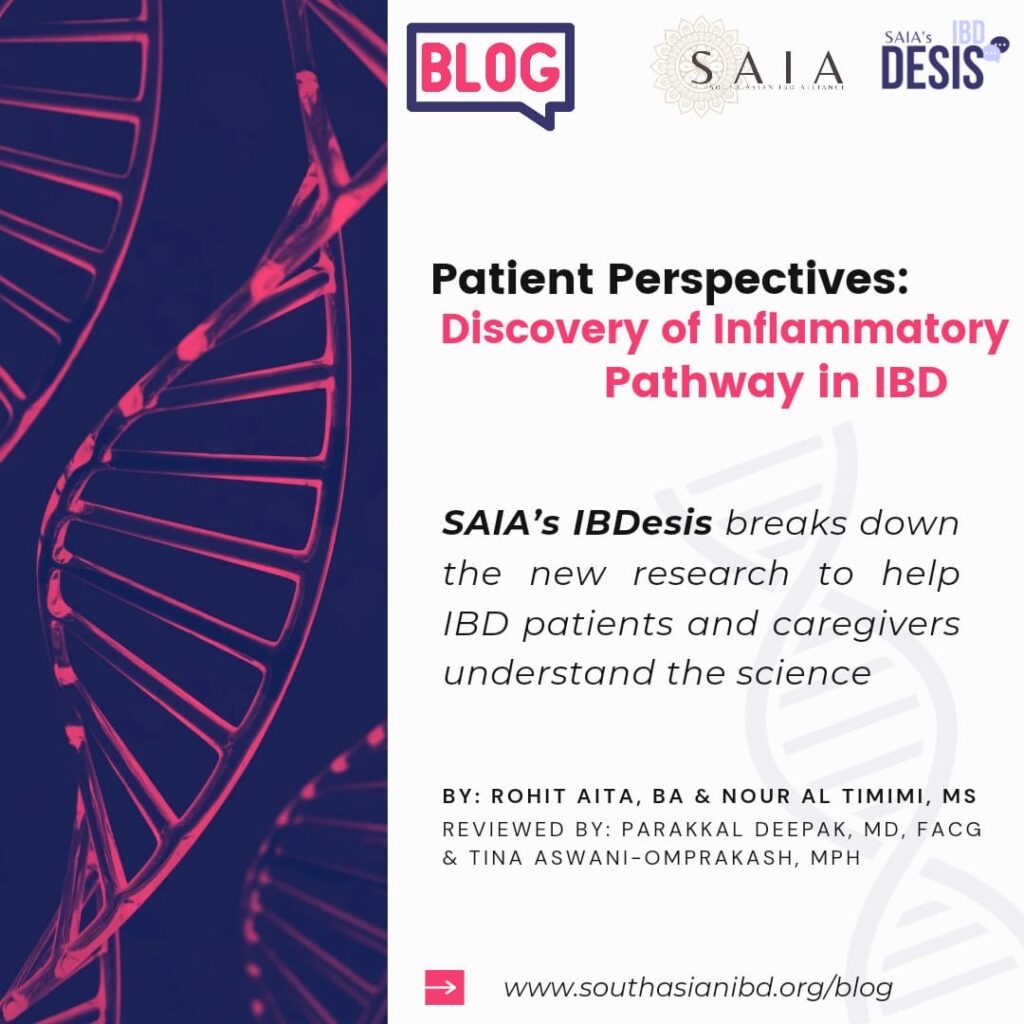
SAIA’s IBDesis breaks down the new research to help IBD patients and caregivers understand the science
By: Rohit Aita, BA & Nour Al Timimi, MS
Reviewed by: Parakkal Deepak, MD, FACG & Tina Aswani-Omprakash, MPH
The recent article published in Nature by Stankey, C.T. et al., titled, “A disease-associated gene desert directs macrophage inflammation through ETS2” has been generating a lot of buzz 🐝 in the news and the IBD patient community [1]. We thought it would be important to clarify some of the key 🔑 points in terms of the science in layman’s terms:
🧬There has been a novel signaling pathway identified through genome wide association studies, a type of genetic study based on population level data, through a gene called ETS2
🧬ETS2 has a major role in controlling a type of cell called macrophages that is activated as part of our innate immune response, which is often the first-line non-specific immune defense we have for many microbes and pathogens in our body
🧬When ETS2 is overexpressed, the disease state macrophage response resembles the inflammatory response seen in IBD
🧬What makes this study novel and impactful is that ETS2 overexpression also leads to the overexpression in other previous drug targets. Here are two examples of those drug targets we know well in the autoimmune space:
🧬(1) IL23A is targeted by Guselkumab, Risankizumab, and Tildrakizumab
🧬(2) TNF-alpha is targeted by Adalimumab and Infliximab
🧬What remains to be seen is how effective and safe targeting this signaling pathway will be in the clinical setting. Here are two challenges identified by the study co-authors:
🧬We do not have ETS2 inhibitors yet
🧬MEK1/2 inhibitors (a pair of signaling pathways with great overlap with the ETS2 immune response) do exist and have shown similar responses to that of infliximab in the lab setting, but they have many side effects [2]:
🧬Cardiovascular
🧬Diarrhea
🧬Fatigue
🧬Nausea/vomiting
🧬Nail fold infections
🧬Rash/skin toxicity
Nevertheless, this is an important breakthrough in our understanding of IBD and can add a potential new class of therapeutics to our arsenal in treating IBD!
We encourage everyone to check out the below breakdown of the article posted to X (Twitter) by Dr. James C. Lee, corresponding author and clinician-scientist who helped lead the study: https://twitter.com/Dr_James_Lee/status/1799040690225344645
What Can Patients Expect:
A recent breakthrough in research has identified a gene (ETS2) that is involved in the pathogenesis of IBD, potentially revolutionizing how IBD can be treated. This discovery sheds light on one of the underlying mechanisms of IBD, offering details for more effective treatments and improved patient outcomes.
The research identified a key gene desert associated with macrophage inflammation, which can be targeted using existing drugs. This breakthrough offers new information for developing more effective treatments and potentially preventing flare-ups of disease by addressing the ETS2 gene, a contributor to the development of IBD.
The key takeaway from the results is that this discovery could lead to more personalized and targeted therapies for IBD patients, improving their quality of life and reducing the frequency and severity of disease relapses. It underscores the importance of ongoing research and the potential for existing medications to be repurposed to treat IBD more effectively.
Key Takeaways
- Major Inflammatory Pathway Identified: Researchers have pinpointed a gene that could be contributing to the development of IBD, which is a substantial step forward in understanding the disease’s etiology.
- Implications for Treatment: This discovery could lead to the development of new, targeted therapies that can help better manage the disease.
- Research and Development: The findings pave the way for more focused research, potentially accelerating the discovery of more effective treatment options.
Importance of Not Jumping to Conclusions
- Preliminary Nature of Research: While the discovery is promising, it is essential to recognize that it is an early finding. Further research is necessary to confirm the results and fully understand their implications.
- Scientific Validation: Breakthroughs need to undergo rigorous testing and validation in clinical settings to ensure their effectiveness and safety for patients.
- Avoiding Overhype: While this is hopeful news, patients should remain cautious based on initial findings. It’s important to follow developments and wait for conclusive evidence before expecting new treatments to become available. Remember, new treatments require rigorous clinical trials and diverse participation from our patient community.
Conclusion
We at SAIA are excited about this development. This breakthrough offers hope for patients affected by IBD, signaling potential advancements in treatment. However, it’s crucial to temper excitement with patience and scientific scrutiny to ensure that future treatments are both effective and safe.
References
[1] Stankey, C.T., Bourges, C., Haag, L.M. et al. A disease-associated gene desert directs macrophage inflammation through ETS2. Nature 630, 447–456 (2024). https://doi.org/10.1038/s41586-024-07501-1
[2] Laura J. Klesse, Justin T. Jordan, Heather B. Radtke, Tena Rosser, Elizabeth Schorry, Nicole Ullrich, David Viskochil, Pamela Knight, Scott R. Plotkin, Kaleb Yohay, The Use of MEK Inhibitors in Neurofibromatosis Type 1–Associated Tumors and Management of Toxicities, The Oncologist, Volume 25, Issue 7, July 2020, Pages e1109–e1116, https://doi.org/10.1634/theoncologist.2020-0069
